Project Risk & Procurement: Risk Management Strategy Analysis
VerifiedAdded on 2023/04/05
|18
|3751
|103
Report
AI Summary
This report provides a comprehensive analysis of risk management within project management, emphasizing the importance of identifying, planning, and mitigating risks for successful project completion. It defines risk in the context of projects, outlines the processes for planning and managing risks, and details mitigation strategies including risk avoidance, sharing, and reduction. The report also addresses the significance of strategic procurement and supply chain management, highlighting the risks associated with supply chains and the importance of sustainable procurement practices. The document underscores the necessity of a proactive risk management approach to minimize uncertainties and ensure project objectives are met, while also noting that Desklib offers additional resources and solved assignments for students.
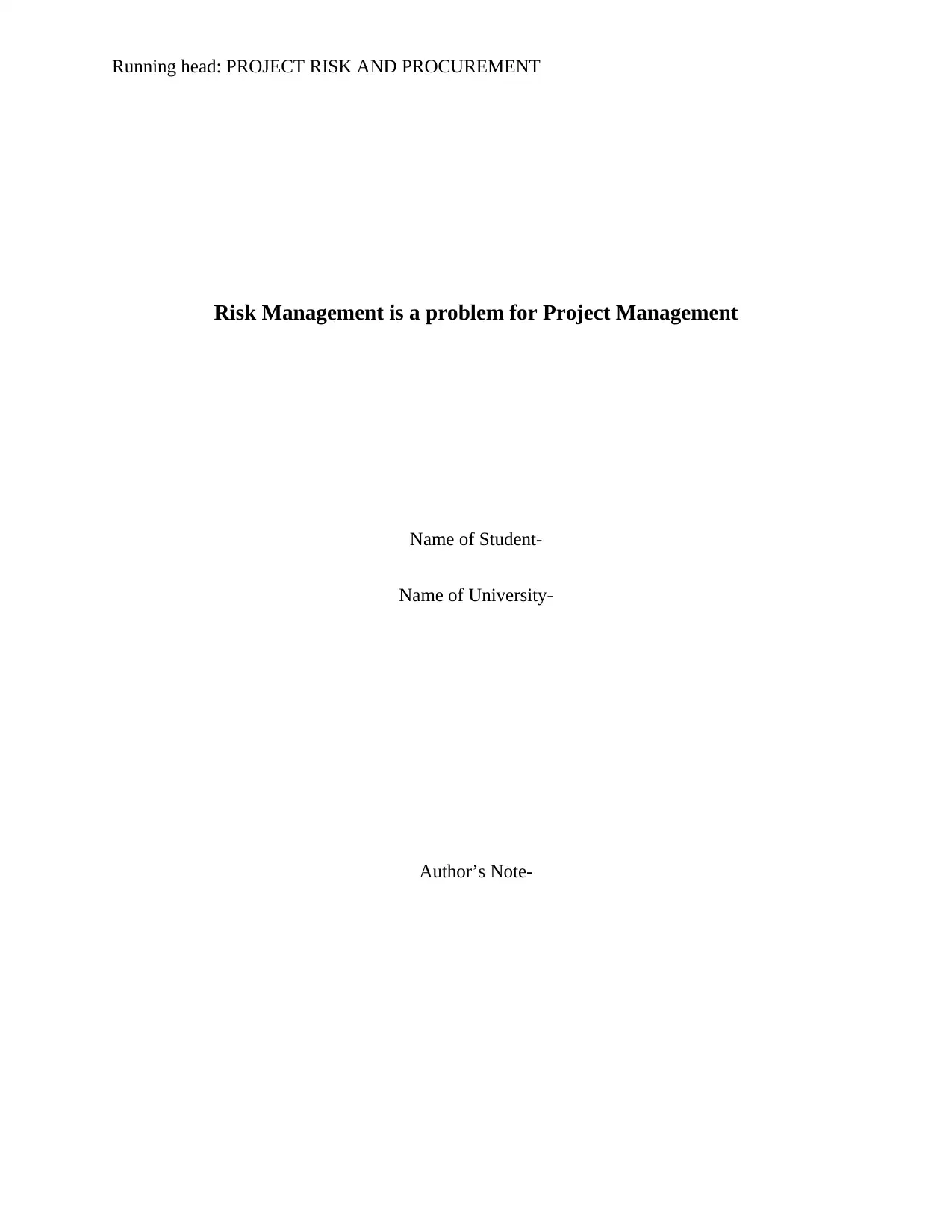
Running head: PROJECT RISK AND PROCUREMENT
Risk Management is a problem for Project Management
Name of Student-
Name of University-
Author’s Note-
Risk Management is a problem for Project Management
Name of Student-
Name of University-
Author’s Note-
Paraphrase This Document
Need a fresh take? Get an instant paraphrase of this document with our AI Paraphraser
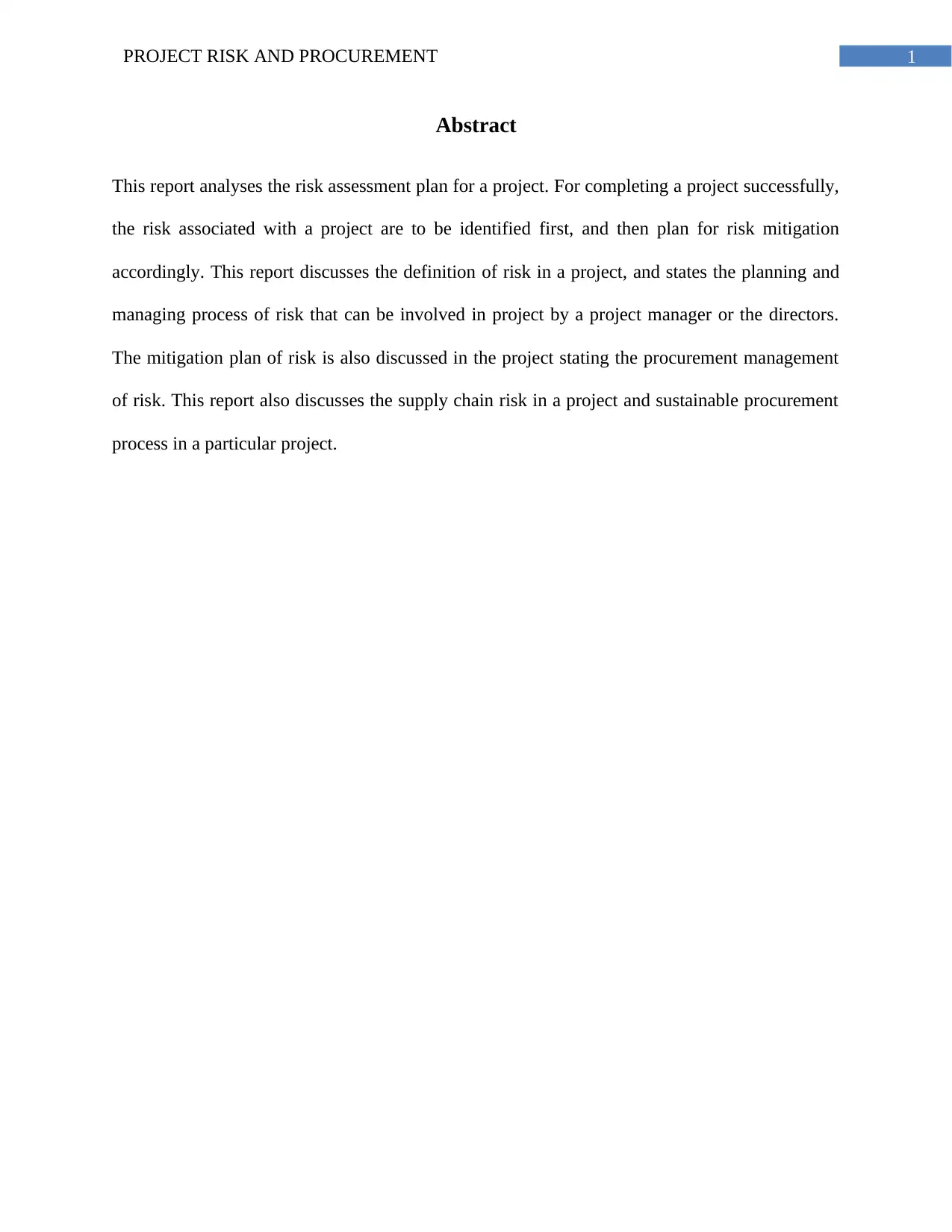
1PROJECT RISK AND PROCUREMENT
Abstract
This report analyses the risk assessment plan for a project. For completing a project successfully,
the risk associated with a project are to be identified first, and then plan for risk mitigation
accordingly. This report discusses the definition of risk in a project, and states the planning and
managing process of risk that can be involved in project by a project manager or the directors.
The mitigation plan of risk is also discussed in the project stating the procurement management
of risk. This report also discusses the supply chain risk in a project and sustainable procurement
process in a particular project.
Abstract
This report analyses the risk assessment plan for a project. For completing a project successfully,
the risk associated with a project are to be identified first, and then plan for risk mitigation
accordingly. This report discusses the definition of risk in a project, and states the planning and
managing process of risk that can be involved in project by a project manager or the directors.
The mitigation plan of risk is also discussed in the project stating the procurement management
of risk. This report also discusses the supply chain risk in a project and sustainable procurement
process in a particular project.
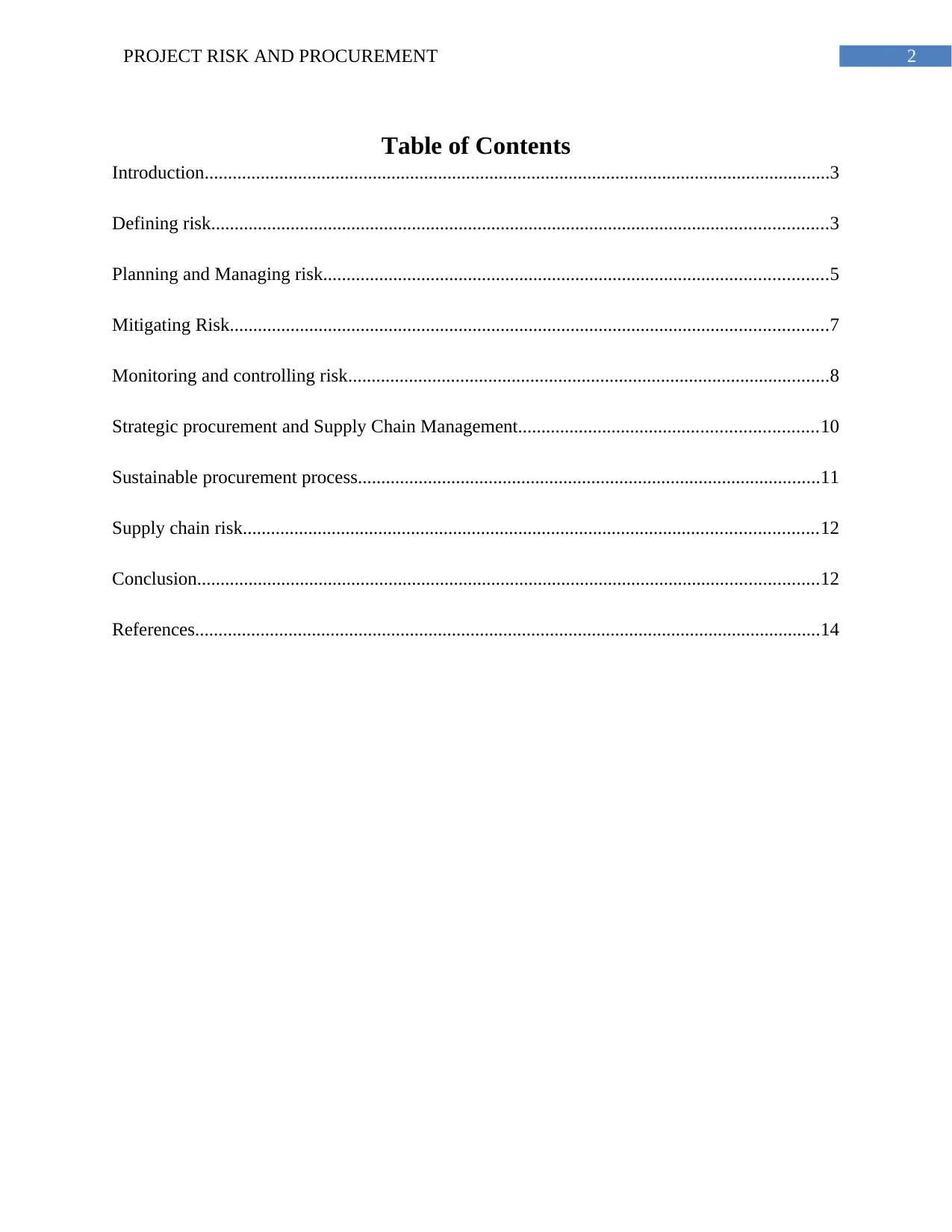
2PROJECT RISK AND PROCUREMENT
Table of Contents
Introduction......................................................................................................................................3
Defining risk....................................................................................................................................3
Planning and Managing risk............................................................................................................5
Mitigating Risk................................................................................................................................7
Monitoring and controlling risk.......................................................................................................8
Strategic procurement and Supply Chain Management................................................................10
Sustainable procurement process...................................................................................................11
Supply chain risk...........................................................................................................................12
Conclusion.....................................................................................................................................12
References......................................................................................................................................14
Table of Contents
Introduction......................................................................................................................................3
Defining risk....................................................................................................................................3
Planning and Managing risk............................................................................................................5
Mitigating Risk................................................................................................................................7
Monitoring and controlling risk.......................................................................................................8
Strategic procurement and Supply Chain Management................................................................10
Sustainable procurement process...................................................................................................11
Supply chain risk...........................................................................................................................12
Conclusion.....................................................................................................................................12
References......................................................................................................................................14
⊘ This is a preview!⊘
Do you want full access?
Subscribe today to unlock all pages.

Trusted by 1+ million students worldwide
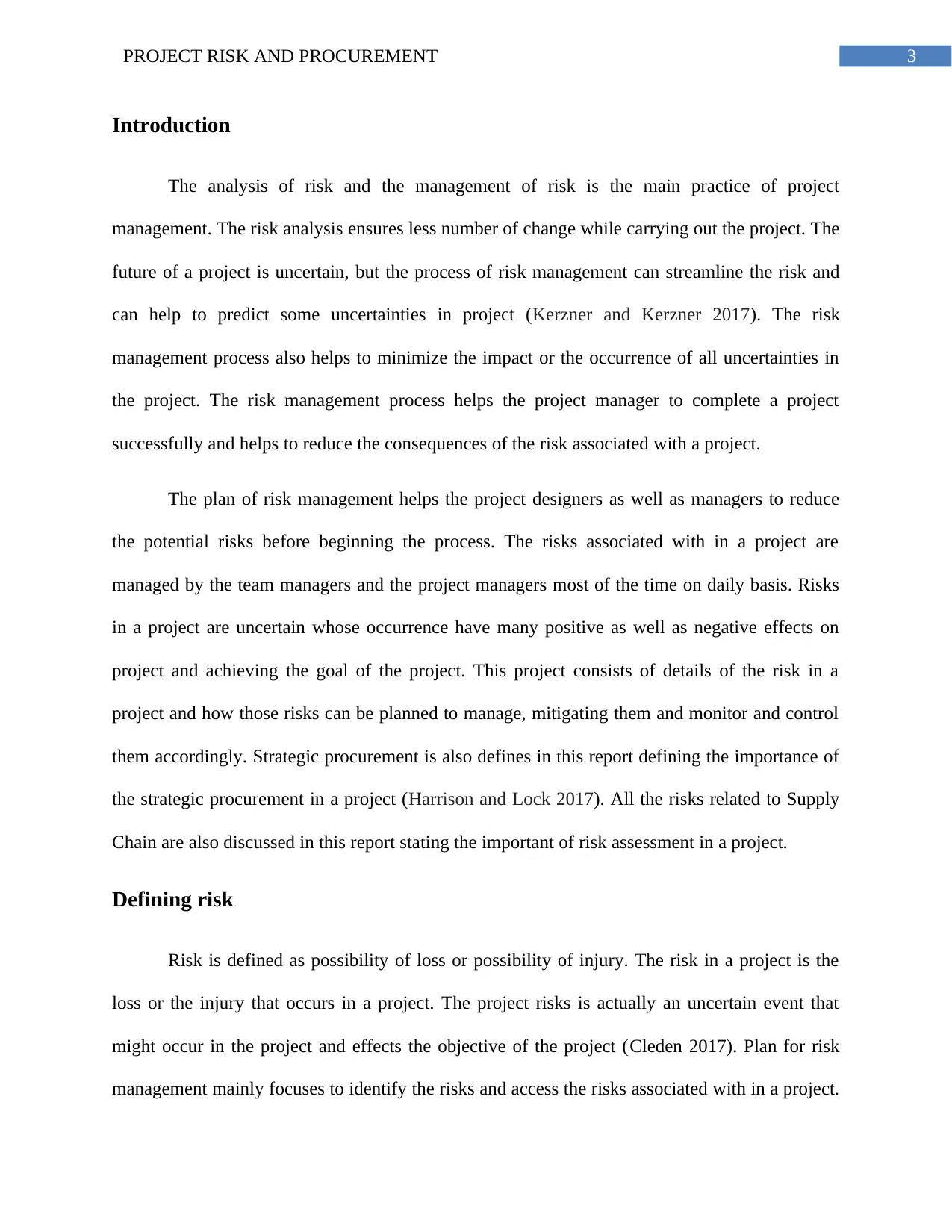
3PROJECT RISK AND PROCUREMENT
Introduction
The analysis of risk and the management of risk is the main practice of project
management. The risk analysis ensures less number of change while carrying out the project. The
future of a project is uncertain, but the process of risk management can streamline the risk and
can help to predict some uncertainties in project (Kerzner and Kerzner 2017). The risk
management process also helps to minimize the impact or the occurrence of all uncertainties in
the project. The risk management process helps the project manager to complete a project
successfully and helps to reduce the consequences of the risk associated with a project.
The plan of risk management helps the project designers as well as managers to reduce
the potential risks before beginning the process. The risks associated with in a project are
managed by the team managers and the project managers most of the time on daily basis. Risks
in a project are uncertain whose occurrence have many positive as well as negative effects on
project and achieving the goal of the project. This project consists of details of the risk in a
project and how those risks can be planned to manage, mitigating them and monitor and control
them accordingly. Strategic procurement is also defines in this report defining the importance of
the strategic procurement in a project (Harrison and Lock 2017). All the risks related to Supply
Chain are also discussed in this report stating the important of risk assessment in a project.
Defining risk
Risk is defined as possibility of loss or possibility of injury. The risk in a project is the
loss or the injury that occurs in a project. The project risks is actually an uncertain event that
might occur in the project and effects the objective of the project (Cleden 2017). Plan for risk
management mainly focuses to identify the risks and access the risks associated with in a project.
Introduction
The analysis of risk and the management of risk is the main practice of project
management. The risk analysis ensures less number of change while carrying out the project. The
future of a project is uncertain, but the process of risk management can streamline the risk and
can help to predict some uncertainties in project (Kerzner and Kerzner 2017). The risk
management process also helps to minimize the impact or the occurrence of all uncertainties in
the project. The risk management process helps the project manager to complete a project
successfully and helps to reduce the consequences of the risk associated with a project.
The plan of risk management helps the project designers as well as managers to reduce
the potential risks before beginning the process. The risks associated with in a project are
managed by the team managers and the project managers most of the time on daily basis. Risks
in a project are uncertain whose occurrence have many positive as well as negative effects on
project and achieving the goal of the project. This project consists of details of the risk in a
project and how those risks can be planned to manage, mitigating them and monitor and control
them accordingly. Strategic procurement is also defines in this report defining the importance of
the strategic procurement in a project (Harrison and Lock 2017). All the risks related to Supply
Chain are also discussed in this report stating the important of risk assessment in a project.
Defining risk
Risk is defined as possibility of loss or possibility of injury. The risk in a project is the
loss or the injury that occurs in a project. The project risks is actually an uncertain event that
might occur in the project and effects the objective of the project (Cleden 2017). Plan for risk
management mainly focuses to identify the risks and access the risks associated with in a project.
Paraphrase This Document
Need a fresh take? Get an instant paraphrase of this document with our AI Paraphraser
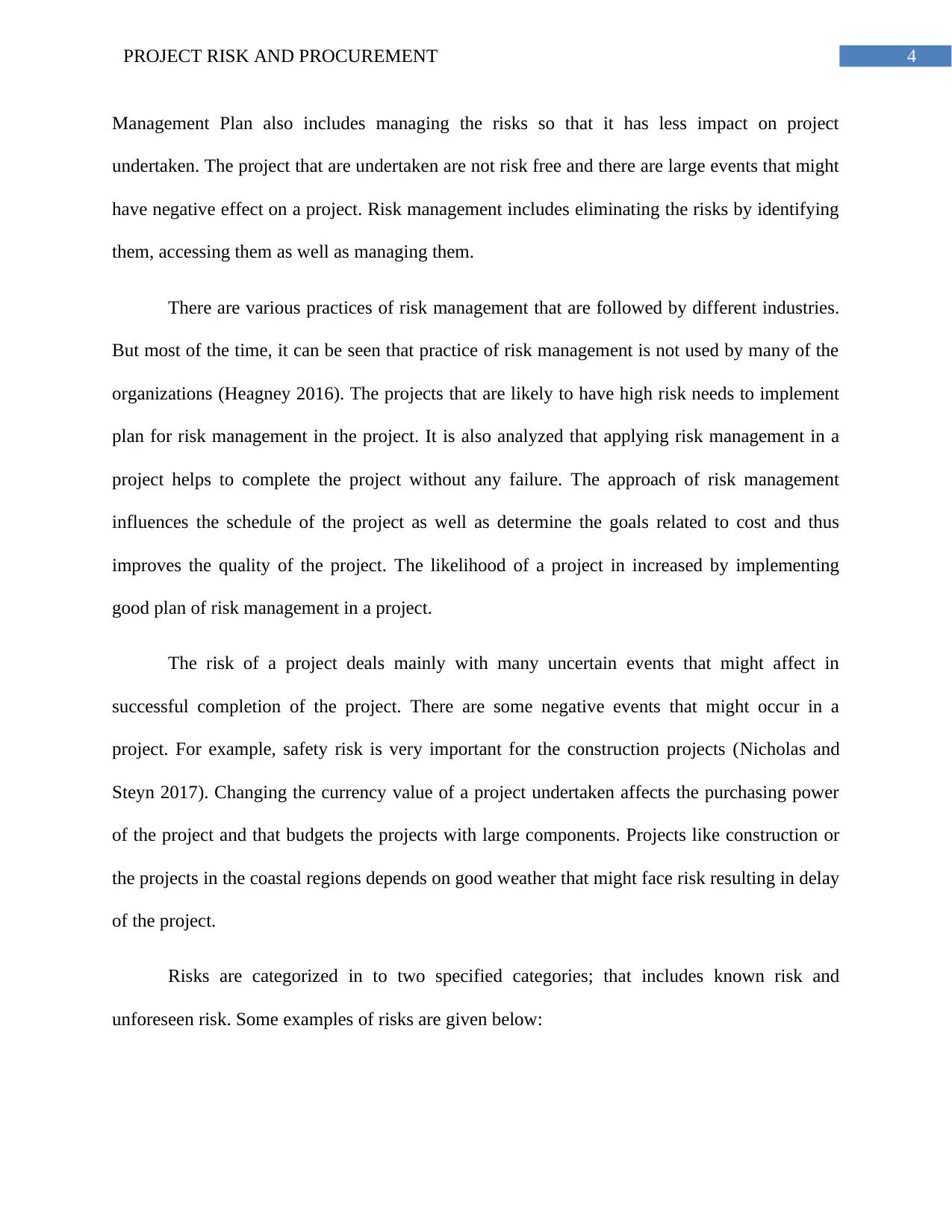
4PROJECT RISK AND PROCUREMENT
Management Plan also includes managing the risks so that it has less impact on project
undertaken. The project that are undertaken are not risk free and there are large events that might
have negative effect on a project. Risk management includes eliminating the risks by identifying
them, accessing them as well as managing them.
There are various practices of risk management that are followed by different industries.
But most of the time, it can be seen that practice of risk management is not used by many of the
organizations (Heagney 2016). The projects that are likely to have high risk needs to implement
plan for risk management in the project. It is also analyzed that applying risk management in a
project helps to complete the project without any failure. The approach of risk management
influences the schedule of the project as well as determine the goals related to cost and thus
improves the quality of the project. The likelihood of a project in increased by implementing
good plan of risk management in a project.
The risk of a project deals mainly with many uncertain events that might affect in
successful completion of the project. There are some negative events that might occur in a
project. For example, safety risk is very important for the construction projects (Nicholas and
Steyn 2017). Changing the currency value of a project undertaken affects the purchasing power
of the project and that budgets the projects with large components. Projects like construction or
the projects in the coastal regions depends on good weather that might face risk resulting in delay
of the project.
Risks are categorized in to two specified categories; that includes known risk and
unforeseen risk. Some examples of risks are given below:
Management Plan also includes managing the risks so that it has less impact on project
undertaken. The project that are undertaken are not risk free and there are large events that might
have negative effect on a project. Risk management includes eliminating the risks by identifying
them, accessing them as well as managing them.
There are various practices of risk management that are followed by different industries.
But most of the time, it can be seen that practice of risk management is not used by many of the
organizations (Heagney 2016). The projects that are likely to have high risk needs to implement
plan for risk management in the project. It is also analyzed that applying risk management in a
project helps to complete the project without any failure. The approach of risk management
influences the schedule of the project as well as determine the goals related to cost and thus
improves the quality of the project. The likelihood of a project in increased by implementing
good plan of risk management in a project.
The risk of a project deals mainly with many uncertain events that might affect in
successful completion of the project. There are some negative events that might occur in a
project. For example, safety risk is very important for the construction projects (Nicholas and
Steyn 2017). Changing the currency value of a project undertaken affects the purchasing power
of the project and that budgets the projects with large components. Projects like construction or
the projects in the coastal regions depends on good weather that might face risk resulting in delay
of the project.
Risks are categorized in to two specified categories; that includes known risk and
unforeseen risk. Some examples of risks are given below:
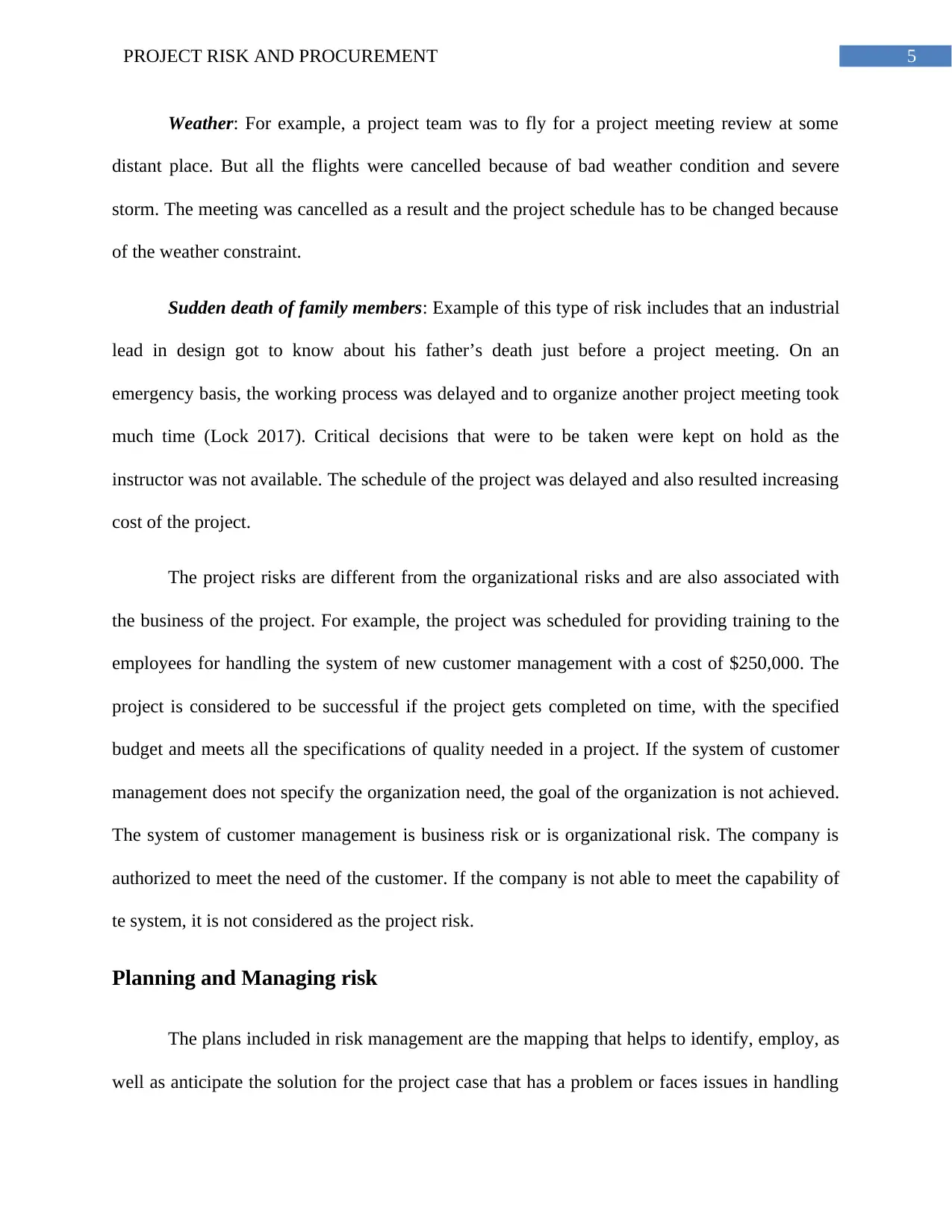
5PROJECT RISK AND PROCUREMENT
Weather: For example, a project team was to fly for a project meeting review at some
distant place. But all the flights were cancelled because of bad weather condition and severe
storm. The meeting was cancelled as a result and the project schedule has to be changed because
of the weather constraint.
Sudden death of family members: Example of this type of risk includes that an industrial
lead in design got to know about his father’s death just before a project meeting. On an
emergency basis, the working process was delayed and to organize another project meeting took
much time (Lock 2017). Critical decisions that were to be taken were kept on hold as the
instructor was not available. The schedule of the project was delayed and also resulted increasing
cost of the project.
The project risks are different from the organizational risks and are also associated with
the business of the project. For example, the project was scheduled for providing training to the
employees for handling the system of new customer management with a cost of $250,000. The
project is considered to be successful if the project gets completed on time, with the specified
budget and meets all the specifications of quality needed in a project. If the system of customer
management does not specify the organization need, the goal of the organization is not achieved.
The system of customer management is business risk or is organizational risk. The company is
authorized to meet the need of the customer. If the company is not able to meet the capability of
te system, it is not considered as the project risk.
Planning and Managing risk
The plans included in risk management are the mapping that helps to identify, employ, as
well as anticipate the solution for the project case that has a problem or faces issues in handling
Weather: For example, a project team was to fly for a project meeting review at some
distant place. But all the flights were cancelled because of bad weather condition and severe
storm. The meeting was cancelled as a result and the project schedule has to be changed because
of the weather constraint.
Sudden death of family members: Example of this type of risk includes that an industrial
lead in design got to know about his father’s death just before a project meeting. On an
emergency basis, the working process was delayed and to organize another project meeting took
much time (Lock 2017). Critical decisions that were to be taken were kept on hold as the
instructor was not available. The schedule of the project was delayed and also resulted increasing
cost of the project.
The project risks are different from the organizational risks and are also associated with
the business of the project. For example, the project was scheduled for providing training to the
employees for handling the system of new customer management with a cost of $250,000. The
project is considered to be successful if the project gets completed on time, with the specified
budget and meets all the specifications of quality needed in a project. If the system of customer
management does not specify the organization need, the goal of the organization is not achieved.
The system of customer management is business risk or is organizational risk. The company is
authorized to meet the need of the customer. If the company is not able to meet the capability of
te system, it is not considered as the project risk.
Planning and Managing risk
The plans included in risk management are the mapping that helps to identify, employ, as
well as anticipate the solution for the project case that has a problem or faces issues in handling
⊘ This is a preview!⊘
Do you want full access?
Subscribe today to unlock all pages.

Trusted by 1+ million students worldwide
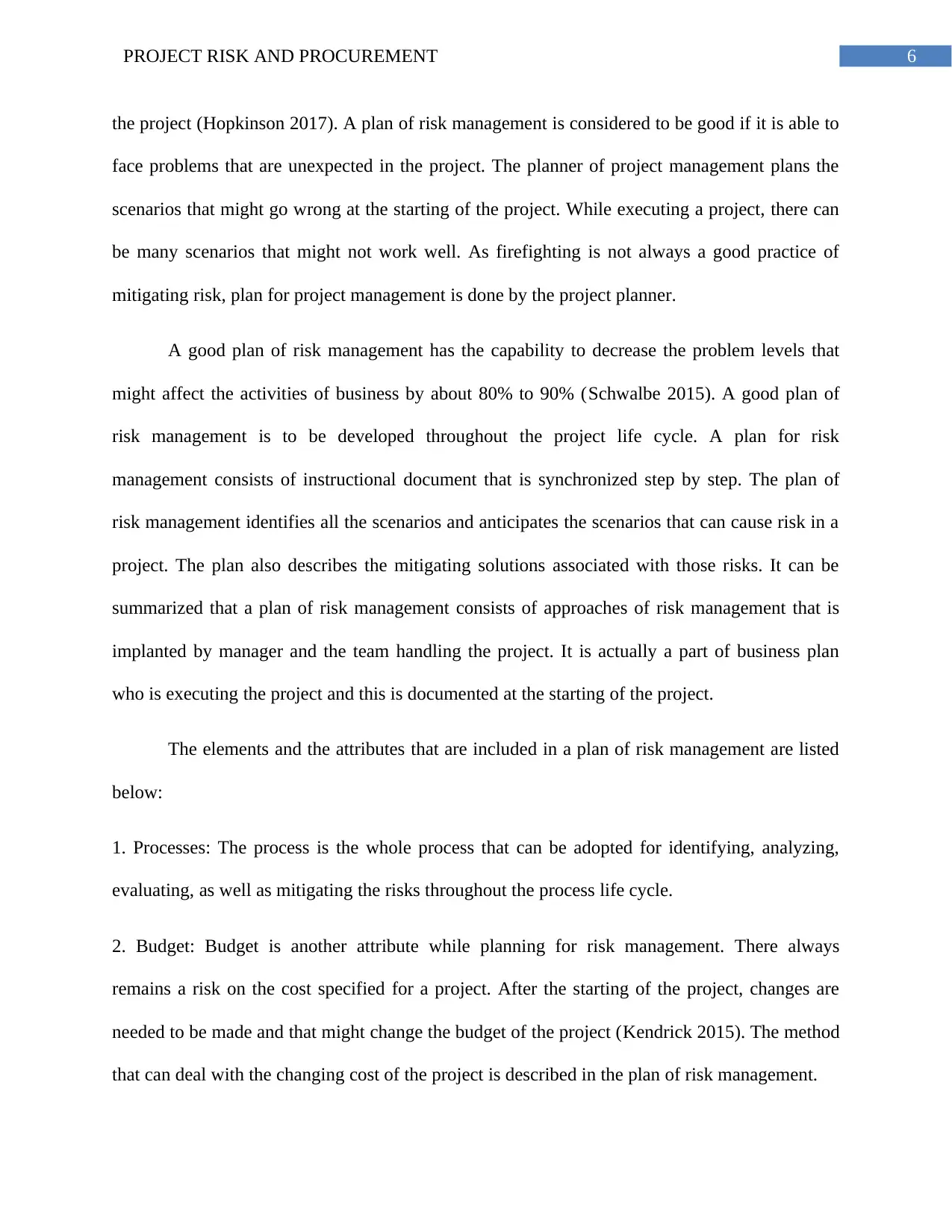
6PROJECT RISK AND PROCUREMENT
the project (Hopkinson 2017). A plan of risk management is considered to be good if it is able to
face problems that are unexpected in the project. The planner of project management plans the
scenarios that might go wrong at the starting of the project. While executing a project, there can
be many scenarios that might not work well. As firefighting is not always a good practice of
mitigating risk, plan for project management is done by the project planner.
A good plan of risk management has the capability to decrease the problem levels that
might affect the activities of business by about 80% to 90% (Schwalbe 2015). A good plan of
risk management is to be developed throughout the project life cycle. A plan for risk
management consists of instructional document that is synchronized step by step. The plan of
risk management identifies all the scenarios and anticipates the scenarios that can cause risk in a
project. The plan also describes the mitigating solutions associated with those risks. It can be
summarized that a plan of risk management consists of approaches of risk management that is
implanted by manager and the team handling the project. It is actually a part of business plan
who is executing the project and this is documented at the starting of the project.
The elements and the attributes that are included in a plan of risk management are listed
below:
1. Processes: The process is the whole process that can be adopted for identifying, analyzing,
evaluating, as well as mitigating the risks throughout the process life cycle.
2. Budget: Budget is another attribute while planning for risk management. There always
remains a risk on the cost specified for a project. After the starting of the project, changes are
needed to be made and that might change the budget of the project (Kendrick 2015). The method
that can deal with the changing cost of the project is described in the plan of risk management.
the project (Hopkinson 2017). A plan of risk management is considered to be good if it is able to
face problems that are unexpected in the project. The planner of project management plans the
scenarios that might go wrong at the starting of the project. While executing a project, there can
be many scenarios that might not work well. As firefighting is not always a good practice of
mitigating risk, plan for project management is done by the project planner.
A good plan of risk management has the capability to decrease the problem levels that
might affect the activities of business by about 80% to 90% (Schwalbe 2015). A good plan of
risk management is to be developed throughout the project life cycle. A plan for risk
management consists of instructional document that is synchronized step by step. The plan of
risk management identifies all the scenarios and anticipates the scenarios that can cause risk in a
project. The plan also describes the mitigating solutions associated with those risks. It can be
summarized that a plan of risk management consists of approaches of risk management that is
implanted by manager and the team handling the project. It is actually a part of business plan
who is executing the project and this is documented at the starting of the project.
The elements and the attributes that are included in a plan of risk management are listed
below:
1. Processes: The process is the whole process that can be adopted for identifying, analyzing,
evaluating, as well as mitigating the risks throughout the process life cycle.
2. Budget: Budget is another attribute while planning for risk management. There always
remains a risk on the cost specified for a project. After the starting of the project, changes are
needed to be made and that might change the budget of the project (Kendrick 2015). The method
that can deal with the changing cost of the project is described in the plan of risk management.
Paraphrase This Document
Need a fresh take? Get an instant paraphrase of this document with our AI Paraphraser
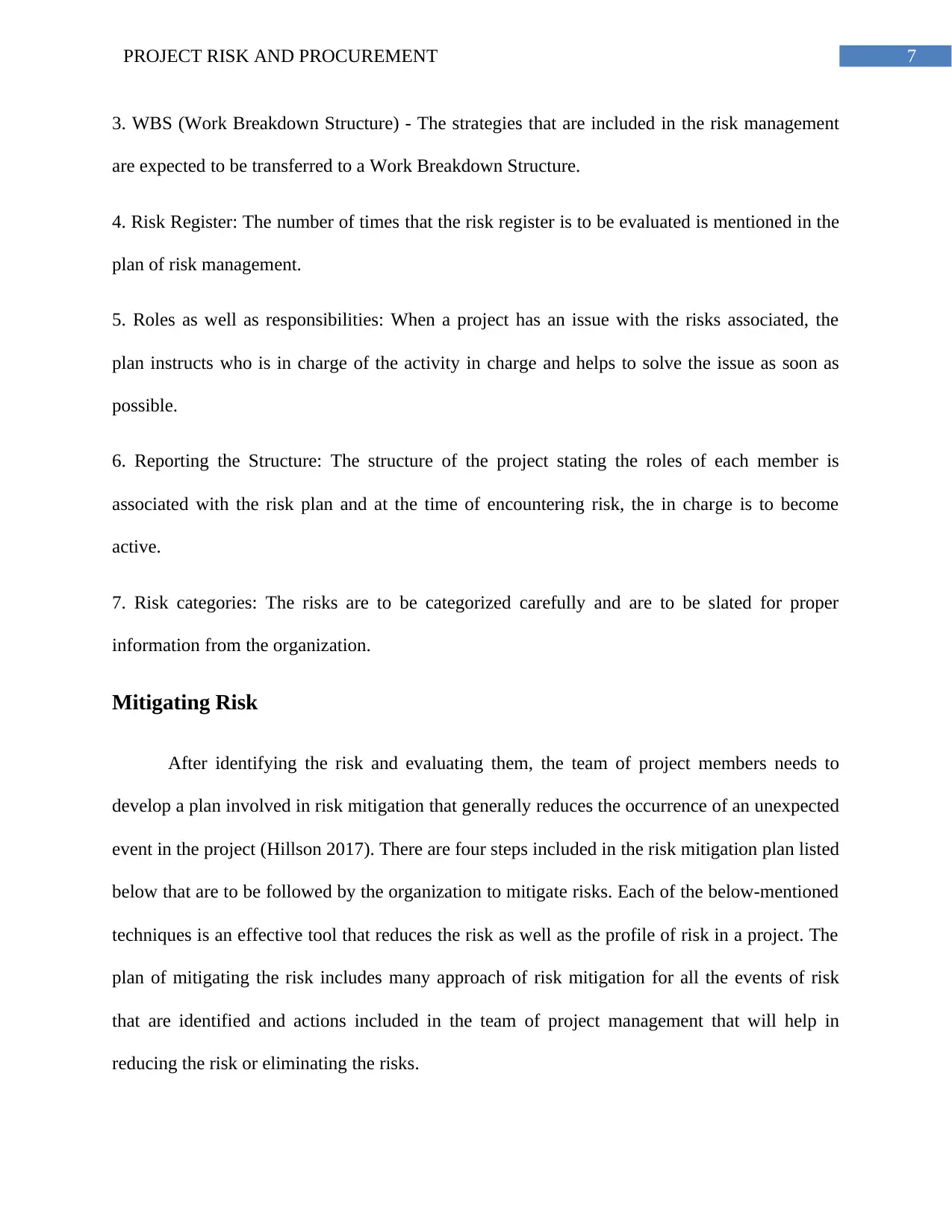
7PROJECT RISK AND PROCUREMENT
3. WBS (Work Breakdown Structure) - The strategies that are included in the risk management
are expected to be transferred to a Work Breakdown Structure.
4. Risk Register: The number of times that the risk register is to be evaluated is mentioned in the
plan of risk management.
5. Roles as well as responsibilities: When a project has an issue with the risks associated, the
plan instructs who is in charge of the activity in charge and helps to solve the issue as soon as
possible.
6. Reporting the Structure: The structure of the project stating the roles of each member is
associated with the risk plan and at the time of encountering risk, the in charge is to become
active.
7. Risk categories: The risks are to be categorized carefully and are to be slated for proper
information from the organization.
Mitigating Risk
After identifying the risk and evaluating them, the team of project members needs to
develop a plan involved in risk mitigation that generally reduces the occurrence of an unexpected
event in the project (Hillson 2017). There are four steps included in the risk mitigation plan listed
below that are to be followed by the organization to mitigate risks. Each of the below-mentioned
techniques is an effective tool that reduces the risk as well as the profile of risk in a project. The
plan of mitigating the risk includes many approach of risk mitigation for all the events of risk
that are identified and actions included in the team of project management that will help in
reducing the risk or eliminating the risks.
3. WBS (Work Breakdown Structure) - The strategies that are included in the risk management
are expected to be transferred to a Work Breakdown Structure.
4. Risk Register: The number of times that the risk register is to be evaluated is mentioned in the
plan of risk management.
5. Roles as well as responsibilities: When a project has an issue with the risks associated, the
plan instructs who is in charge of the activity in charge and helps to solve the issue as soon as
possible.
6. Reporting the Structure: The structure of the project stating the roles of each member is
associated with the risk plan and at the time of encountering risk, the in charge is to become
active.
7. Risk categories: The risks are to be categorized carefully and are to be slated for proper
information from the organization.
Mitigating Risk
After identifying the risk and evaluating them, the team of project members needs to
develop a plan involved in risk mitigation that generally reduces the occurrence of an unexpected
event in the project (Hillson 2017). There are four steps included in the risk mitigation plan listed
below that are to be followed by the organization to mitigate risks. Each of the below-mentioned
techniques is an effective tool that reduces the risk as well as the profile of risk in a project. The
plan of mitigating the risk includes many approach of risk mitigation for all the events of risk
that are identified and actions included in the team of project management that will help in
reducing the risk or eliminating the risks.
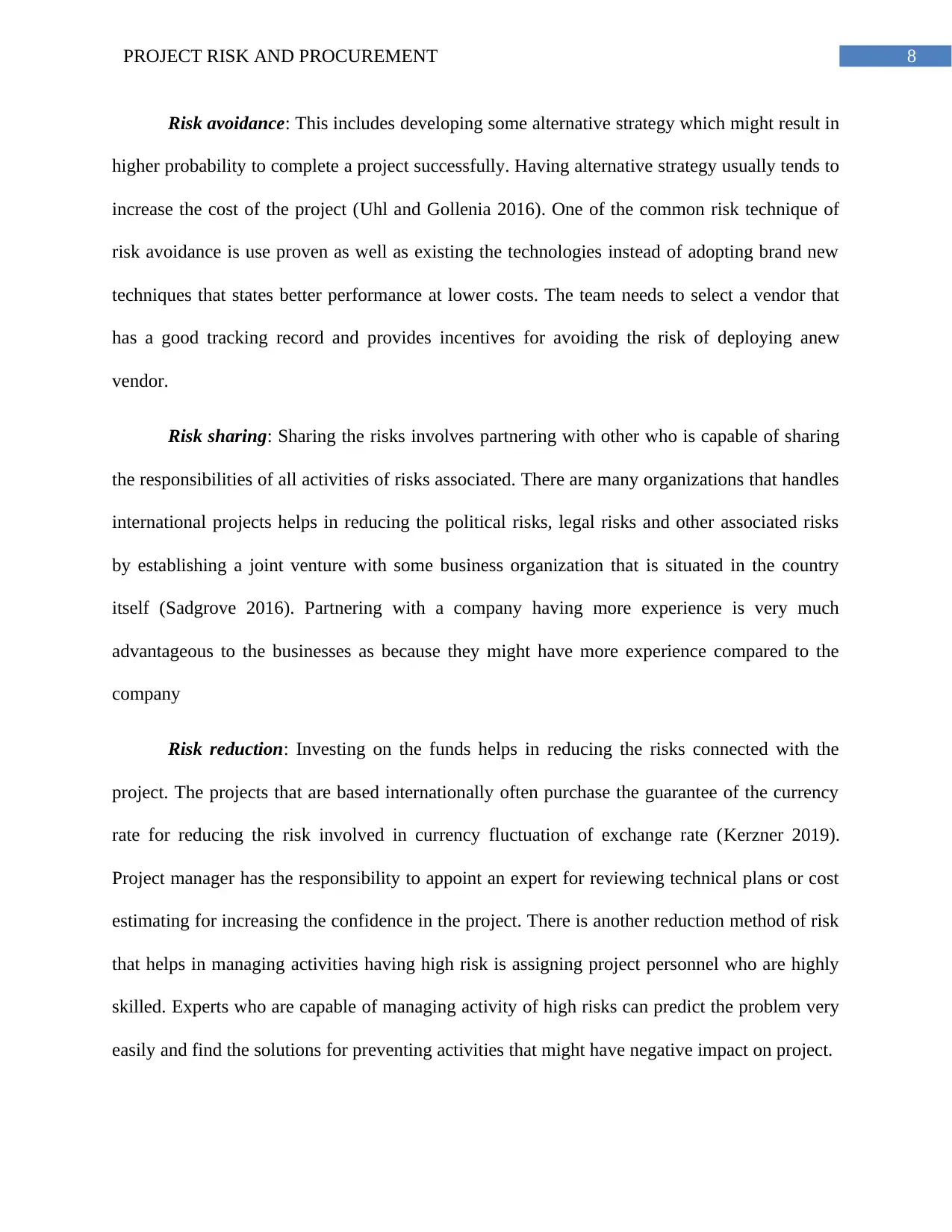
8PROJECT RISK AND PROCUREMENT
Risk avoidance: This includes developing some alternative strategy which might result in
higher probability to complete a project successfully. Having alternative strategy usually tends to
increase the cost of the project (Uhl and Gollenia 2016). One of the common risk technique of
risk avoidance is use proven as well as existing the technologies instead of adopting brand new
techniques that states better performance at lower costs. The team needs to select a vendor that
has a good tracking record and provides incentives for avoiding the risk of deploying anew
vendor.
Risk sharing: Sharing the risks involves partnering with other who is capable of sharing
the responsibilities of all activities of risks associated. There are many organizations that handles
international projects helps in reducing the political risks, legal risks and other associated risks
by establishing a joint venture with some business organization that is situated in the country
itself (Sadgrove 2016). Partnering with a company having more experience is very much
advantageous to the businesses as because they might have more experience compared to the
company
Risk reduction: Investing on the funds helps in reducing the risks connected with the
project. The projects that are based internationally often purchase the guarantee of the currency
rate for reducing the risk involved in currency fluctuation of exchange rate (Kerzner 2019).
Project manager has the responsibility to appoint an expert for reviewing technical plans or cost
estimating for increasing the confidence in the project. There is another reduction method of risk
that helps in managing activities having high risk is assigning project personnel who are highly
skilled. Experts who are capable of managing activity of high risks can predict the problem very
easily and find the solutions for preventing activities that might have negative impact on project.
Risk avoidance: This includes developing some alternative strategy which might result in
higher probability to complete a project successfully. Having alternative strategy usually tends to
increase the cost of the project (Uhl and Gollenia 2016). One of the common risk technique of
risk avoidance is use proven as well as existing the technologies instead of adopting brand new
techniques that states better performance at lower costs. The team needs to select a vendor that
has a good tracking record and provides incentives for avoiding the risk of deploying anew
vendor.
Risk sharing: Sharing the risks involves partnering with other who is capable of sharing
the responsibilities of all activities of risks associated. There are many organizations that handles
international projects helps in reducing the political risks, legal risks and other associated risks
by establishing a joint venture with some business organization that is situated in the country
itself (Sadgrove 2016). Partnering with a company having more experience is very much
advantageous to the businesses as because they might have more experience compared to the
company
Risk reduction: Investing on the funds helps in reducing the risks connected with the
project. The projects that are based internationally often purchase the guarantee of the currency
rate for reducing the risk involved in currency fluctuation of exchange rate (Kerzner 2019).
Project manager has the responsibility to appoint an expert for reviewing technical plans or cost
estimating for increasing the confidence in the project. There is another reduction method of risk
that helps in managing activities having high risk is assigning project personnel who are highly
skilled. Experts who are capable of managing activity of high risks can predict the problem very
easily and find the solutions for preventing activities that might have negative impact on project.
⊘ This is a preview!⊘
Do you want full access?
Subscribe today to unlock all pages.

Trusted by 1+ million students worldwide
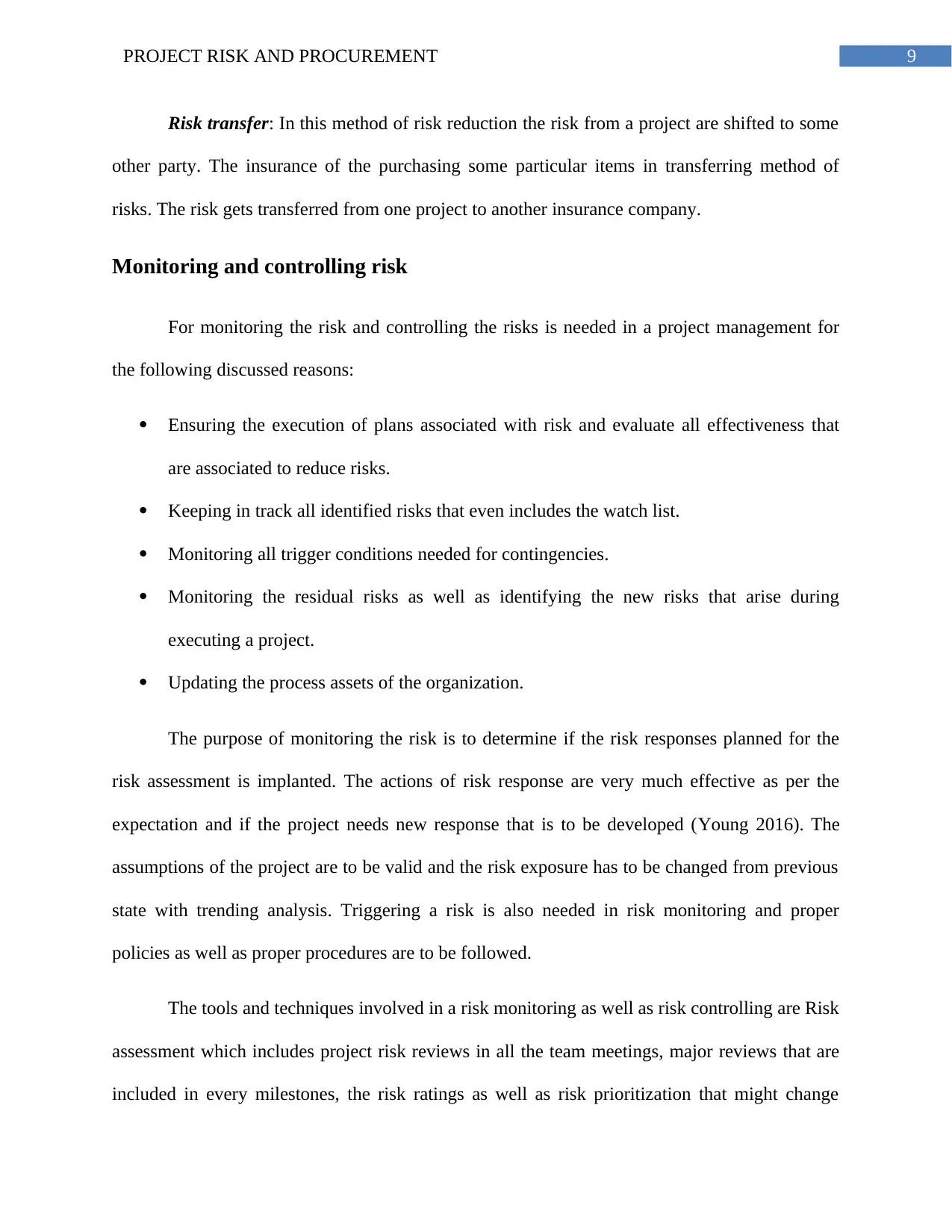
9PROJECT RISK AND PROCUREMENT
Risk transfer: In this method of risk reduction the risk from a project are shifted to some
other party. The insurance of the purchasing some particular items in transferring method of
risks. The risk gets transferred from one project to another insurance company.
Monitoring and controlling risk
For monitoring the risk and controlling the risks is needed in a project management for
the following discussed reasons:
Ensuring the execution of plans associated with risk and evaluate all effectiveness that
are associated to reduce risks.
Keeping in track all identified risks that even includes the watch list.
Monitoring all trigger conditions needed for contingencies.
Monitoring the residual risks as well as identifying the new risks that arise during
executing a project.
Updating the process assets of the organization.
The purpose of monitoring the risk is to determine if the risk responses planned for the
risk assessment is implanted. The actions of risk response are very much effective as per the
expectation and if the project needs new response that is to be developed (Young 2016). The
assumptions of the project are to be valid and the risk exposure has to be changed from previous
state with trending analysis. Triggering a risk is also needed in risk monitoring and proper
policies as well as proper procedures are to be followed.
The tools and techniques involved in a risk monitoring as well as risk controlling are Risk
assessment which includes project risk reviews in all the team meetings, major reviews that are
included in every milestones, the risk ratings as well as risk prioritization that might change
Risk transfer: In this method of risk reduction the risk from a project are shifted to some
other party. The insurance of the purchasing some particular items in transferring method of
risks. The risk gets transferred from one project to another insurance company.
Monitoring and controlling risk
For monitoring the risk and controlling the risks is needed in a project management for
the following discussed reasons:
Ensuring the execution of plans associated with risk and evaluate all effectiveness that
are associated to reduce risks.
Keeping in track all identified risks that even includes the watch list.
Monitoring all trigger conditions needed for contingencies.
Monitoring the residual risks as well as identifying the new risks that arise during
executing a project.
Updating the process assets of the organization.
The purpose of monitoring the risk is to determine if the risk responses planned for the
risk assessment is implanted. The actions of risk response are very much effective as per the
expectation and if the project needs new response that is to be developed (Young 2016). The
assumptions of the project are to be valid and the risk exposure has to be changed from previous
state with trending analysis. Triggering a risk is also needed in risk monitoring and proper
policies as well as proper procedures are to be followed.
The tools and techniques involved in a risk monitoring as well as risk controlling are Risk
assessment which includes project risk reviews in all the team meetings, major reviews that are
included in every milestones, the risk ratings as well as risk prioritization that might change
Paraphrase This Document
Need a fresh take? Get an instant paraphrase of this document with our AI Paraphraser
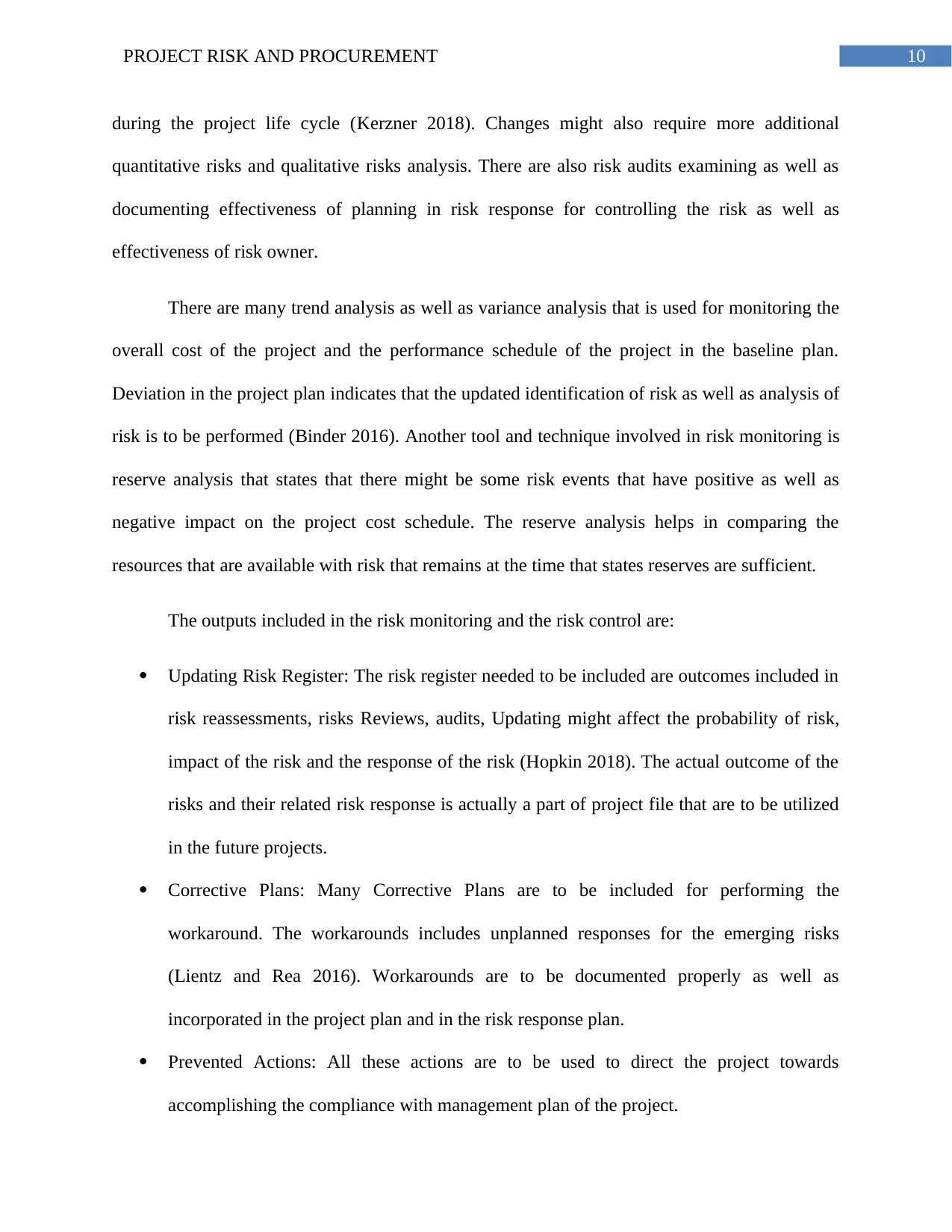
10PROJECT RISK AND PROCUREMENT
during the project life cycle (Kerzner 2018). Changes might also require more additional
quantitative risks and qualitative risks analysis. There are also risk audits examining as well as
documenting effectiveness of planning in risk response for controlling the risk as well as
effectiveness of risk owner.
There are many trend analysis as well as variance analysis that is used for monitoring the
overall cost of the project and the performance schedule of the project in the baseline plan.
Deviation in the project plan indicates that the updated identification of risk as well as analysis of
risk is to be performed (Binder 2016). Another tool and technique involved in risk monitoring is
reserve analysis that states that there might be some risk events that have positive as well as
negative impact on the project cost schedule. The reserve analysis helps in comparing the
resources that are available with risk that remains at the time that states reserves are sufficient.
The outputs included in the risk monitoring and the risk control are:
Updating Risk Register: The risk register needed to be included are outcomes included in
risk reassessments, risks Reviews, audits, Updating might affect the probability of risk,
impact of the risk and the response of the risk (Hopkin 2018). The actual outcome of the
risks and their related risk response is actually a part of project file that are to be utilized
in the future projects.
Corrective Plans: Many Corrective Plans are to be included for performing the
workaround. The workarounds includes unplanned responses for the emerging risks
(Lientz and Rea 2016). Workarounds are to be documented properly as well as
incorporated in the project plan and in the risk response plan.
Prevented Actions: All these actions are to be used to direct the project towards
accomplishing the compliance with management plan of the project.
during the project life cycle (Kerzner 2018). Changes might also require more additional
quantitative risks and qualitative risks analysis. There are also risk audits examining as well as
documenting effectiveness of planning in risk response for controlling the risk as well as
effectiveness of risk owner.
There are many trend analysis as well as variance analysis that is used for monitoring the
overall cost of the project and the performance schedule of the project in the baseline plan.
Deviation in the project plan indicates that the updated identification of risk as well as analysis of
risk is to be performed (Binder 2016). Another tool and technique involved in risk monitoring is
reserve analysis that states that there might be some risk events that have positive as well as
negative impact on the project cost schedule. The reserve analysis helps in comparing the
resources that are available with risk that remains at the time that states reserves are sufficient.
The outputs included in the risk monitoring and the risk control are:
Updating Risk Register: The risk register needed to be included are outcomes included in
risk reassessments, risks Reviews, audits, Updating might affect the probability of risk,
impact of the risk and the response of the risk (Hopkin 2018). The actual outcome of the
risks and their related risk response is actually a part of project file that are to be utilized
in the future projects.
Corrective Plans: Many Corrective Plans are to be included for performing the
workaround. The workarounds includes unplanned responses for the emerging risks
(Lientz and Rea 2016). Workarounds are to be documented properly as well as
incorporated in the project plan and in the risk response plan.
Prevented Actions: All these actions are to be used to direct the project towards
accomplishing the compliance with management plan of the project.
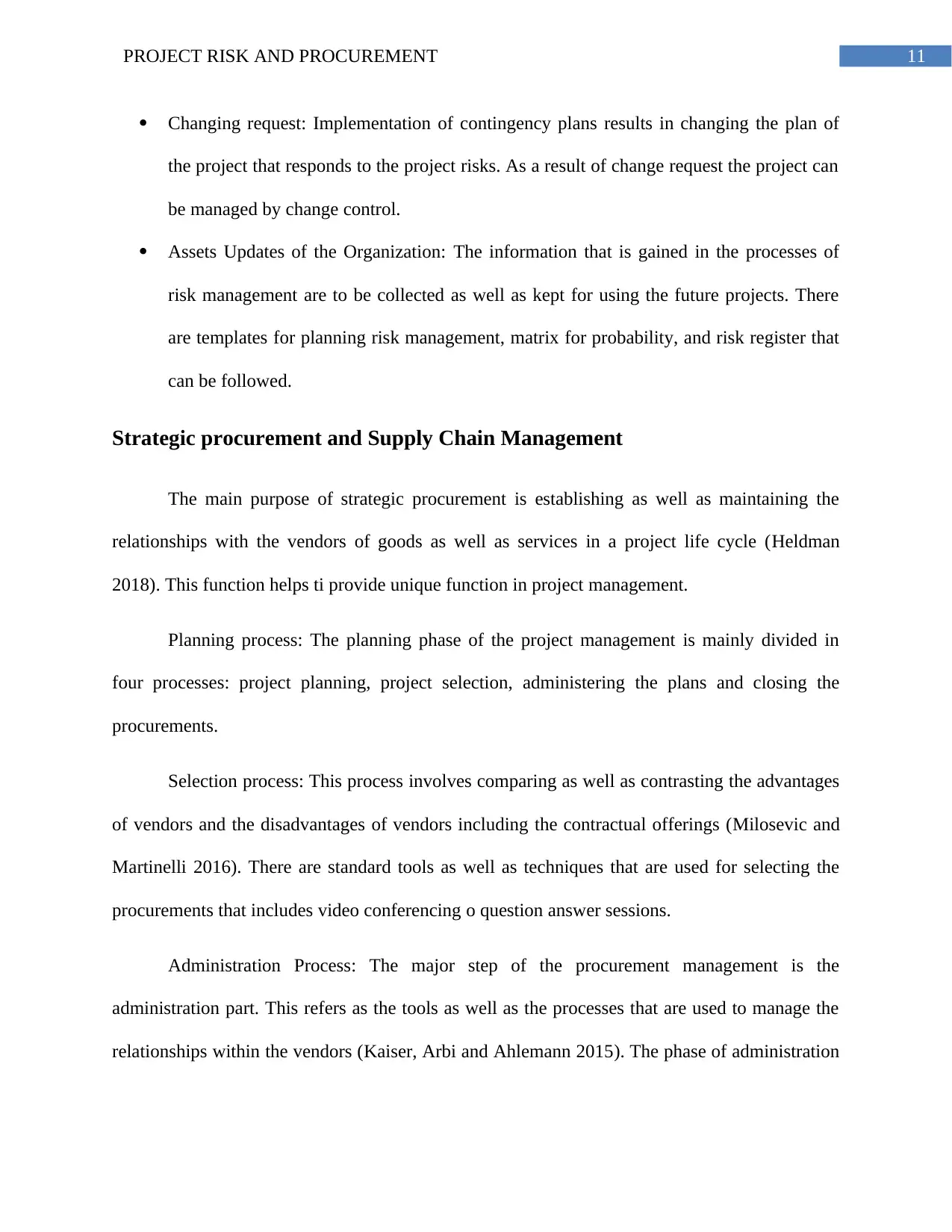
11PROJECT RISK AND PROCUREMENT
Changing request: Implementation of contingency plans results in changing the plan of
the project that responds to the project risks. As a result of change request the project can
be managed by change control.
Assets Updates of the Organization: The information that is gained in the processes of
risk management are to be collected as well as kept for using the future projects. There
are templates for planning risk management, matrix for probability, and risk register that
can be followed.
Strategic procurement and Supply Chain Management
The main purpose of strategic procurement is establishing as well as maintaining the
relationships with the vendors of goods as well as services in a project life cycle (Heldman
2018). This function helps ti provide unique function in project management.
Planning process: The planning phase of the project management is mainly divided in
four processes: project planning, project selection, administering the plans and closing the
procurements.
Selection process: This process involves comparing as well as contrasting the advantages
of vendors and the disadvantages of vendors including the contractual offerings (Milosevic and
Martinelli 2016). There are standard tools as well as techniques that are used for selecting the
procurements that includes video conferencing o question answer sessions.
Administration Process: The major step of the procurement management is the
administration part. This refers as the tools as well as the processes that are used to manage the
relationships within the vendors (Kaiser, Arbi and Ahlemann 2015). The phase of administration
Changing request: Implementation of contingency plans results in changing the plan of
the project that responds to the project risks. As a result of change request the project can
be managed by change control.
Assets Updates of the Organization: The information that is gained in the processes of
risk management are to be collected as well as kept for using the future projects. There
are templates for planning risk management, matrix for probability, and risk register that
can be followed.
Strategic procurement and Supply Chain Management
The main purpose of strategic procurement is establishing as well as maintaining the
relationships with the vendors of goods as well as services in a project life cycle (Heldman
2018). This function helps ti provide unique function in project management.
Planning process: The planning phase of the project management is mainly divided in
four processes: project planning, project selection, administering the plans and closing the
procurements.
Selection process: This process involves comparing as well as contrasting the advantages
of vendors and the disadvantages of vendors including the contractual offerings (Milosevic and
Martinelli 2016). There are standard tools as well as techniques that are used for selecting the
procurements that includes video conferencing o question answer sessions.
Administration Process: The major step of the procurement management is the
administration part. This refers as the tools as well as the processes that are used to manage the
relationships within the vendors (Kaiser, Arbi and Ahlemann 2015). The phase of administration
⊘ This is a preview!⊘
Do you want full access?
Subscribe today to unlock all pages.

Trusted by 1+ million students worldwide
1 out of 18
Related Documents
Your All-in-One AI-Powered Toolkit for Academic Success.
+13062052269
info@desklib.com
Available 24*7 on WhatsApp / Email
![[object Object]](/_next/static/media/star-bottom.7253800d.svg)
Unlock your academic potential
Copyright © 2020–2025 A2Z Services. All Rights Reserved. Developed and managed by ZUCOL.





